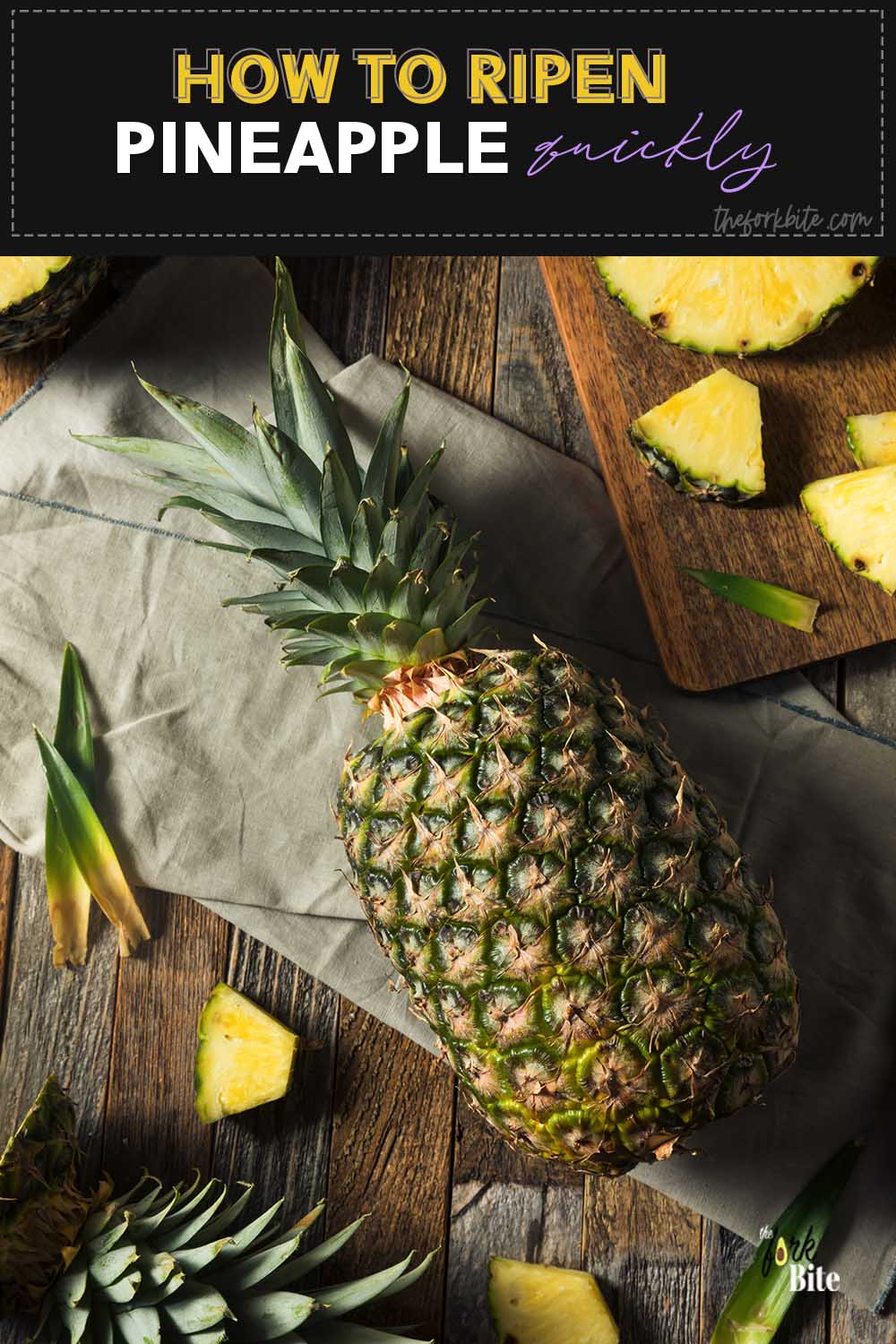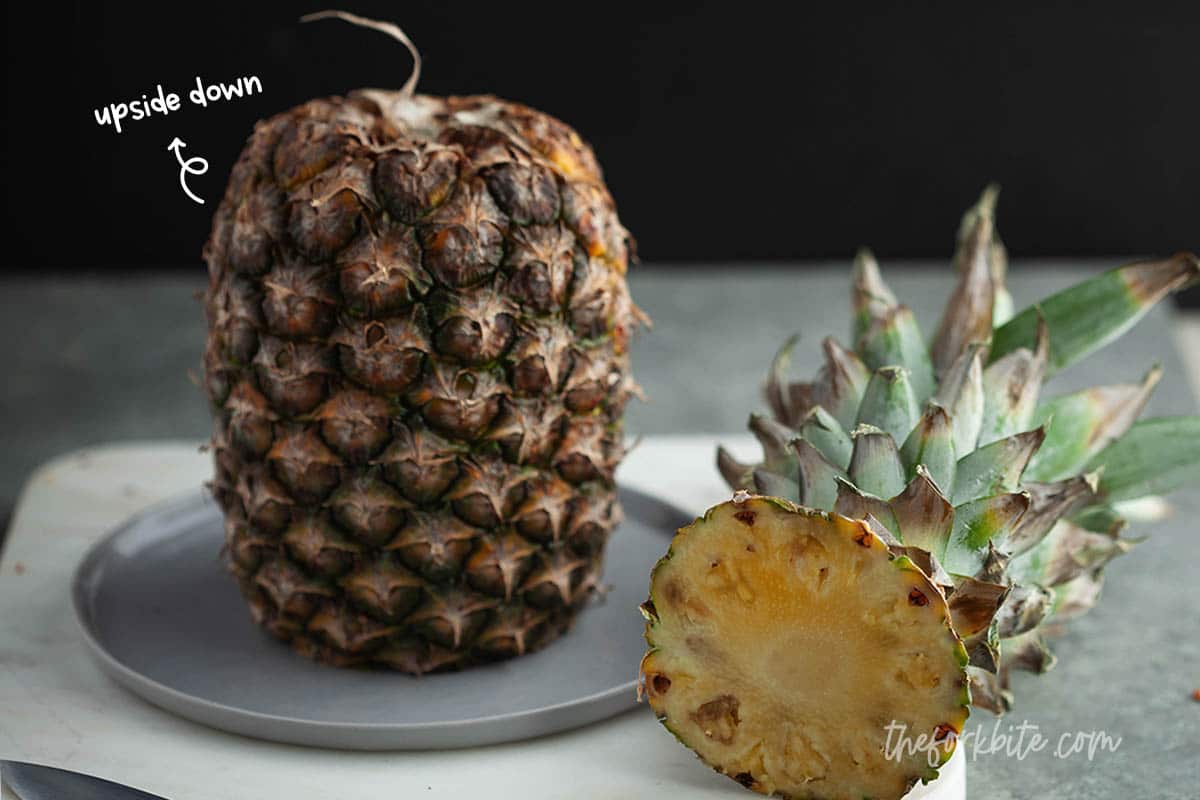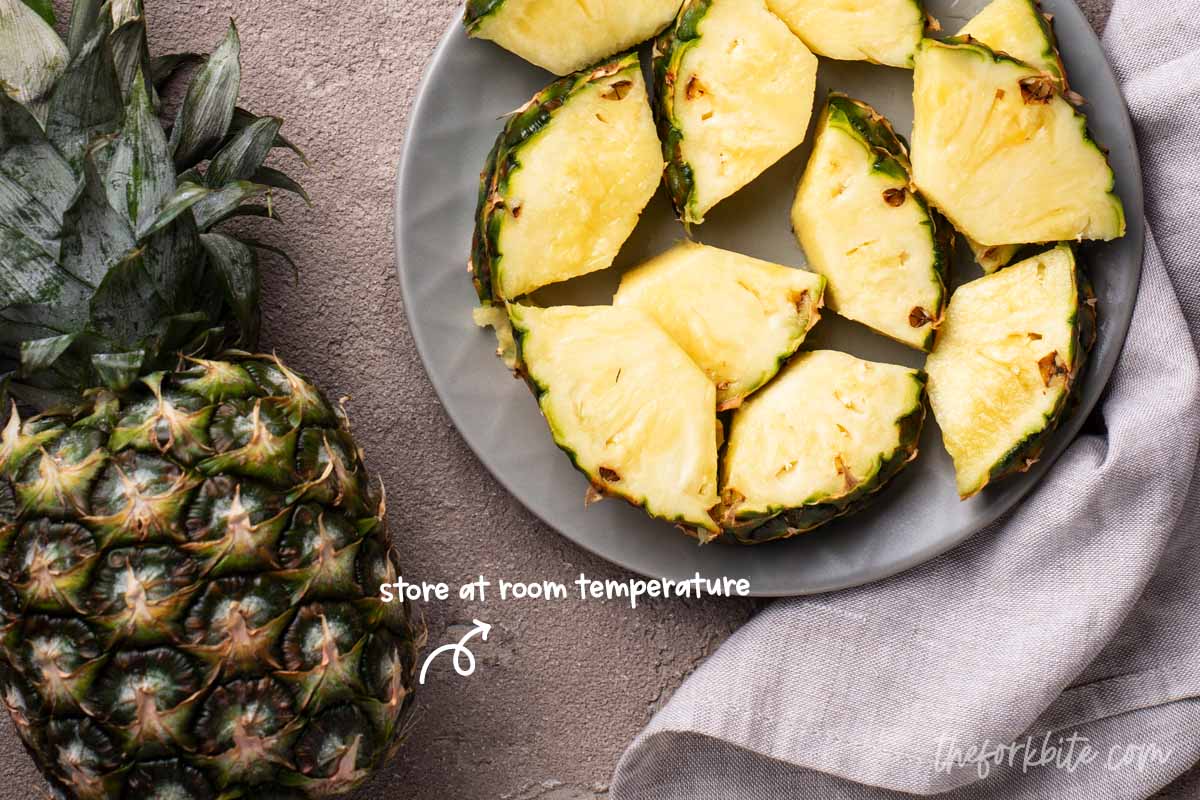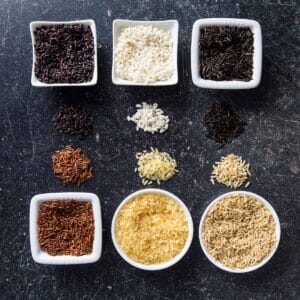Once you pick a pineapple of the tree, the natural ripening process stops. There are few tricks on how to ripen the pineapple quickly that you can try. Read on to learn more.
You go to the shop, buy a beautiful pineapple which you think will be ripe to eat in a day or two. However, after a few days of standing there upright, it feels no softer.
You get fed up with waiting and end-up eating it unripe. The texture is hard, and there is little sweetness. Sound familiar? Well, here is something you need to know. It will never ripen properly!
Jump to:
Once you pick a pineapple of the tree, the natural ripening process stops. It's not like some other fruits which ripen if you leave them a few days after harvesting. With a pineapple, it does not matter how long you wait - if it is not already ripe, it never will be.
It reminds me of the joke about a boiling an egg, whereby a guy says, "I've tried boiling eggs for hours, but they never seem to soften." Guess what, they never will, in the same way, that an unripe pineapple won't ripen.
Pineapple will get softer if you leave it for long enough, but it is not ripening - it's rotting. You can eat it in the early stages of spoiling, but the sweetness is not there, and the texture will deteriorate.
There are, however, a few "tricks of the trade" you can try. Read on, and I will reveal all.
Two Tricks on how to ripen pineapple quickly
1 Upside down trick
While it is true that left stood up on its base, a pineapple will not ripen, you can make it happen if you turn it upside down.
A "topsy-turvy" pineapple, balanced on its stem, (where the leaves sprout out from), will ripen a little. This is after all the way it grows in nature.
If there is any starch left in the fruit, it will be in the base. By standing it upside down, any remaining starch will migrate down towards the center.
This will begin a fermentation process that will turn the starch into sugar, adding a little sweetness.
If the pineapple refuses to stand, you can cut the stem section off and position the exposed end on damp kitchen paper. It's not a miracle cure, but with a little luck, it will sweeten a little.
2 Store at room temperature
Once a pineapple has been picked, it will begin to soften through a natural fermentation process.
You can speed this up if you store it at room temperature. If you are not yet ready to eat your pineapple, put it in the fridge. This will delay the start of the fermentation process.
There is an interesting video you can watch on YouTube about comparing refrigerated pineapple with pineapple stored on its base at room temperature, pineapple stored on its stem, and at room temperature. Why not take a look?
The paper bag method: does it work?
Some people believe that storing a pineapple in a paper bag, next to other fruit, will ripen it.
But is it true? Well, it certainly works with other fruits, as proven by farmers who use this trick to ripen apples, bananas, and pears.
But the fact of the matter is that it does not work with pineapples.
What it does do is to quicken the color change of the pineapple from green to gold. But, in terms of ripening the flavor, it does nothing.
Helpful tips to know if a pineapple is ripe.
When you go out to buy pineapples, it is best to buy ones that had been picked during the summertime. These have a sweeter taste than those picked during the winter. They also contain less acid, which is better for your body system.
Judging the ripeness of a pineapple.
As you can tell from what I have said so far, pineapples taste much sweeter if you buy them fully ripe.
But how can you know whether they are ripe or not? Here are some useful tips.
1 Going by the color
When you conjure up an image of pineapple in your mind's eye, you will almost certainly picture something greenish-yellow in color. However, the pineapple's outer skin goes from a greenish-grey to yellow as it continues to ripen. In other words, the more yellow looking the pineapple, the riper it is likely to be.
Ideally, you should look to buy a pineapple that is a consistent golden-yellow throughout. If it has turned dark orange, leave it well alone.
As I have already mentioned, pineapples do not ripen much at all once they have been picked. So, when you come across green pineapples at your local grocery store or supermarket, they are not very ripe and will not get much riper - leastwise not without harnessing a few of the tips I am giving you.
2 The feelgood factor
Regardless of the color, all pineapples have spikes. Unlike porcupines, however, pineapples are quite safe to handle. So, you can give them a little squeeze.
There is not an awful lot of difference between an unripe and ripe pineapple. Not like avocados, for example, which can be either rock-solid or quite squidgy. Pineapples go from being rock-solid when un-ripe to being slightly soft if squeezed, when ripe.
3 The smell test
The smell of pineapple is undoubtedly the best test in terms of judging its ripeness. After choosing pineapples that have a little give in them and turning yellow, give them a quick sniff.
Smell the base. If you get a fruity sweet pineapple aroma, you have hit the jackpot.
Can you ripen a pineapple in the refrigerator?
Keeping a pineapple in the refrigerator will not ripen it. Just the opposite, it will delay any ripening process. Unless that is your wish, store your pineapple at room temperature. Once cut, pineapple flesh can be kept in the fridge to keep it fresh for 2 to 3 days.
When deliberately trying to slow down any ripening process, wrap the pineapple in saran wrap and place it inside the fridge.
When storing cut pineapple in the refrigerator, it is best to put it in an airtight container.
For longer-term storage, cut pineapple pieces can be frozen in freezer containers.
If your pineapple begins to smell a bit vinegary, then it has probably been stored too long. Fermented pineapple is not an absolute no-no. Ideally, you want it to happen by design and not by accident.
Curious trivia regarding pineapples
Pineapples are not the most interesting thing in the world, but there are some curious facts about them you may wish to know.
Why does pineapple make my mouth hurt?
Fresh pineapples contain bromelain, an enzyme that acts on proteins, breaking them down. As you eat pineapple flesh, the bromelain goes to work and can sometimes cause irritation or a painful tingling sensation in your mouth.
You will be pleased to know that your stomach has natural inbuilt protection against bromelain, so there is no need to worry about what it might do to you.
In fact, bromelain can be helpful as it is known to reduce inflammation in things like your intestines, joints, sinuses, and other soft tissue. In other words, pineapple is good news for people living with arthritis.
How long does pineapple last?
Pineapple does not have an extended shelf life. You would generally expect to keep it for 2 to 3 days at home and room temperature before it begins to deteriorate.
You can slow deterioration down by keeping it in your fridge for up to 4 to 5 days. However, once you take it out of the refrigerator, leave it for a couple of days before cutting and eating.
How long does cut pineapple last?
If you pre-cut pineapple before eating it, you can store it in the fridge for 3 to 4 days before its quality deteriorates. If you have a sweet tooth, you can halve the fridge time by immersing your cut pineapple in syrup.
Canned pineapple is like any other canned fruit. It should have a "best by" date displayed on the outer can. However, the fruit inside the can is often okay to eat months past its best by date.
As I already advised, if you want to keep cut pineapple for longer, it's best to freeze it.
Here are a few bullet points on improving a pineapple's shelf life.
-
- Cut the pineapple and wrap the pieces tightly in film wrap or aluminum foil before placing it inside either a covered container or a resealable plastic bag.
Once correctly stored, you can keep it in the refrigerator for 3 to 4 days.
-
- If you want to freeze cut pineapple, you should put it inside an airtight container or a proprietary freezer bag.
Frozen, cut pineapple, providing it has been stored correctly, will maintain its quality for up to 10 or 12 months. It can even be eaten after a year.
- Cut pineapple can, in fact, be safely frozen at 0°F indefinitely as long as the temperature remains constant.
How to tell if my pineapple has gone rotten?
Before going rotten, pineapple will degrade in quality. The best tell-tale sign as to the quality of your pineapple is its stem leaves. Once they begin to dry and lose color, delay no longer.
The time has come for your pineapple feast. If you spot any soft spots or bruising of the flesh, these can be cut out, and any uncontaminated flesh can be eaten safely.
It is a fact that once the deterioration process is started, it will continue apace. In other words, don't wait any longer; eat it straight away.
If a pineapple becomes wet and mushy on the bottom, or it develops mold, discard it.
If you think there are some good bits of the pineapple left, you can always cut out the bad. However, to stay on the safe side, binning it is the best idea.
What makes under-ripe fruit taste horrible?
Two organic acids accumulate in fruits and make them taste sour. They are citric acid and malic acid. Citrus fruits, in particular, have more citric acid in them, while other fruits such as apples and pears have more malic acid.
Mother Nature has created the ripening process during which acids, alkaloids, and tannins are synthesized.
Not only does this process fight off infections in the young fruit, but it also serves to make them taste bitter, which is a way of warding off hungry animals that might eat them before they are ready.
What takes place as the fruit ripens?
In growing fruit, the storage cells expand, filling the fruits with water and various nutrients, including minerals, organic acids, starches, sugars, and vitamins.
The fruit of the skin which starts off colored green, changes to other colors such as orange, reds, or yellow as the fruit ripens.
As the growing process continues, the acid and starch contents lessen; alkaloids and tannins vanish, and the sugar content increases.
The smell develops due to changes in the acid and protein content. The texture of the fruit begins to soften as a result of the chemicals that comprise the cell walls start to break down.
The combination of these processes results in the fruit becoming ripe and ready to harvest.
What brings about these changes?
The reason that these changes come about as fruit develops is as a result of enzyme action.
For instance, the color develops when molecules containing chlorophyll become significantly weaker, thus allowing enzymes to neutralize any green pigment.
Other secondary pigments that give the fruit its ripened color begin to develop and show through—the enzymes process starches into sugars.
A hormone known as ethylene, which develops during the ripening process, is responsible for accelerating these changes.
Ethylene is still something of a mystery. However, it is believed that it is responsible for cell membranes becoming more permeable, therefore permitting the enzymes to go about their work.
We know that once ethylene reaches a particular concentration in fruits, the fruit's cells then change from emitting oxygen (which is a byproduct of the photosynthesis process) and, instead, emit carbon dioxide.
This change in the way that fruit breathes, and it accelerates the approaching ripeness.
Of course, fruits do not breathe as animals do. They do, however, obtain the energy required to ripen through absorbing oxygen and emitting carbon dioxide in a process termed "cellular respiration."
Do pineapples continue to ripen after being picked?
As I have already intimated, pineapples do not tend to ripen once they have been picked. However, some fruit does, depending on which type of fruit you are talking about.
Fruits that continue to ripen after harvest include apricots, avocados, bananas and plantain, kiwi fruit, mangos, pears, peaches, nectarines, persimmons, and tomatoes.
Like tomatoes, I tend not to think of avocado as fruit but rather as vegetables. However, that is because I eat them in salads. They are strictly speaking, indeed, fruits.
Climacteric fruits
Fruits mentioned above, from apricots to tomatoes, are known as climacteric fruits.
They are crucial in their development when they ripen due to the increased cellular respiration process discussed earlier. During the latter stages of their maturity, these fruits tend to retain more ethylene.
Climacteric fruit can keep the ethylene it produces while also absorbing it from the environment. This makes these fruits suitable for picking by commercial companies while they are yet to ripen.
This is advantageous to commercial growers because it results in less damage when the fruit is shipped. Ethylene gassing can then take place while the fruit is being transported.
non-climacteric fruits
Non-climacteric fruits are those that can only fully ripen, and achieve their full sweetness, while they are still on the plants. These fruits include things like berries, cherries, citrus fruits, melons, and of course, pineapples.
These fruits do not sweeten once harvested as they do not store their sugars as starch. There is, therefore, no starch to convert to sugar. It means that these fruits are best picked and eaten at the height of their ripeness.
Can ripening be speeded up?
As referred to above, the ripening of climacteric fruit can be speeded up. The hastening process occurs when stored between 70°F and 90°F, thanks to the increase in cellular respiration.
It is also possible to increase the ethylene intake of fruit by loosely placing it in a paper bag with other ethylene rich fruit like bananas and ripe apples. This is, by the way, a great tip for ripening solid avocados or peaches overnight.
Storing fruit that is already ripe
As mentioned earlier, refrigerating fruit will slow down its cellular respiration.
Another trick is to starve the fruit of oxygen and increase the carbon dioxide available to it by putting it into a plastic bag and storing it in your refrigerator.
In the commercial business world, this process is known as "controlled atmosphere storage."
It is how ripened apples are kept before they reach the market. However, to get the best eating experience, it is best to let any cold fruit sit at room temperature for a while to take some of the chills and improve its aroma.
Fruits not to refrigerate
There are, however, some fruits you should not refrigerate. These include whole tomatoes, bananas, and other tropical fruits.
If you chill these types of fruits below 50°F, it can initiate something called "chill injuries."
This can result in loss of color, the texture becoming mealy, and a diminishing in both smell and taste.
Ten great fruit hacks
It's not just computers that can be hacked; fruits can be too.
Here are 10 top tips on how to get sweeter fruit and get it to ripen more quickly.
1 Reducing the sourness of grapefruit
Strange as though it may seem at first sound, a tiny amount of salt can make grapefruit sweeter. This is because the salt reduces the acidity of the grapefruit allowing its natural sweetness to come to the fore.
2 Melons without mold
To prevent melons from developing mold when ripen, you can rub the outer peel with a teaspoon of strong vinegar for a few days until you are ready to eat it. It won't impair the flavor.
3 Preventing cut apples from turning brown
If you don't want your child to have to use a knife to cut the apple in his or her school lunchbox, why not pre-cut the apple at home, then put it back together and keep it intact with a rubber band? It really does work.
4 Fresh looking fruit taste better
It's often only in the mind that fruit that looks fresh tastes better or seems to. There is nothing worse than opening your fruit salad and finding it covered in a thin layer of brown oxidization.
One simple way of avoiding this is to squeeze some fresh lemon juice over the salad.
Another novel way of preventing browning is to top up a spray bottle with water and dissolved some vitamin C tablets into it. Not only will this prevent the oxidization process, but it will also increase your vitamin C ration too.
5 Sweetening mango
If you start eating a mango and it tastes slightly acidic, all you need to do is to submerge it in a bowl of warm water for about 10 minutes.
What this does is to speed up the starches in the mango, turning them into sugar, and your mango will become lovely and sweet.
Don't leave it in that the too long, however, as it could start to shrivel, and there's nothing worse than a shriveled mango!
6 Brown bag magic
We alluded to this earlier on, and it is a trick well worth remembering for ripening fruit quickly. It works particularly well with fruit that gives up ethylene gas, which helps the fruit to ripen.
The ethylene gas cannot escape into the atmosphere by enclosing the fruit in a sealed brown paper bag.
If besides, you add a ripe apple or banana, which are both rich in ethylene, this will make the ripening process even faster.
7 Quick watermelon sorbet
Next time you buy a watermelon, instead of slicing it up - get your ice cream scoop out and dish it up in little balls rather like ice cream or sorbet. Your kids will love it, and it makes for a great, mineral-rich desert too.
8 De-stoning avocado
This one is recommended for adults only as it involves the use of a knife. After splitting your avocado in two, thrust the point of a knife blade into the stone, give it a little twist, and just pull the stone out.
9 Peeling a pommie
Pomegranates make excellent eating, and they are very nutritious too. But if you do what some people do and eat it a pip at a time using a needle, it can be a little tricky. Follow this tip, and do it faster and easier.
First of all, cut the fruit in half and put it in a bowl of cold water. Then, you scrape out the seeds while holding it underwater and then pour the water complete with seeds through a fine-mesh strainer.
Another "cheffy" trick is to halve the pomegranate, hold it upside down over a bowl, and repeatedly bash the back of it with the handle of a knife.
10 The upside-down pineapple trick
This little trick was covered above, but as it is so useful, it is worth repeating. The natural sugars in pineapple tend to settle at the bottom of the fruit.
To get them to migrate to the center, slice off the stem of the pineapple, leaving a flat base, and turn the fruit upside down, placing in on a piece of a damp kitchen cloth.
Leave it for about an hour, and the sugars will work their way through the rest of the fruit. Yum!









